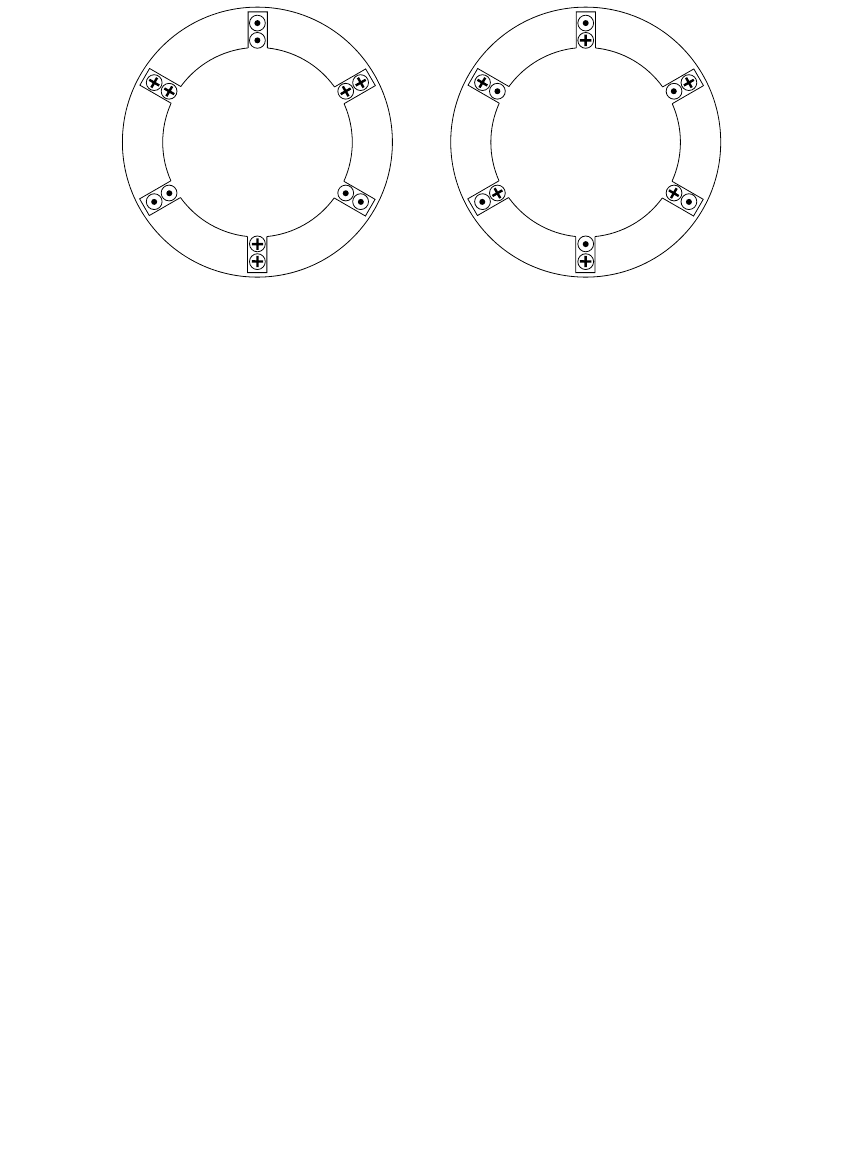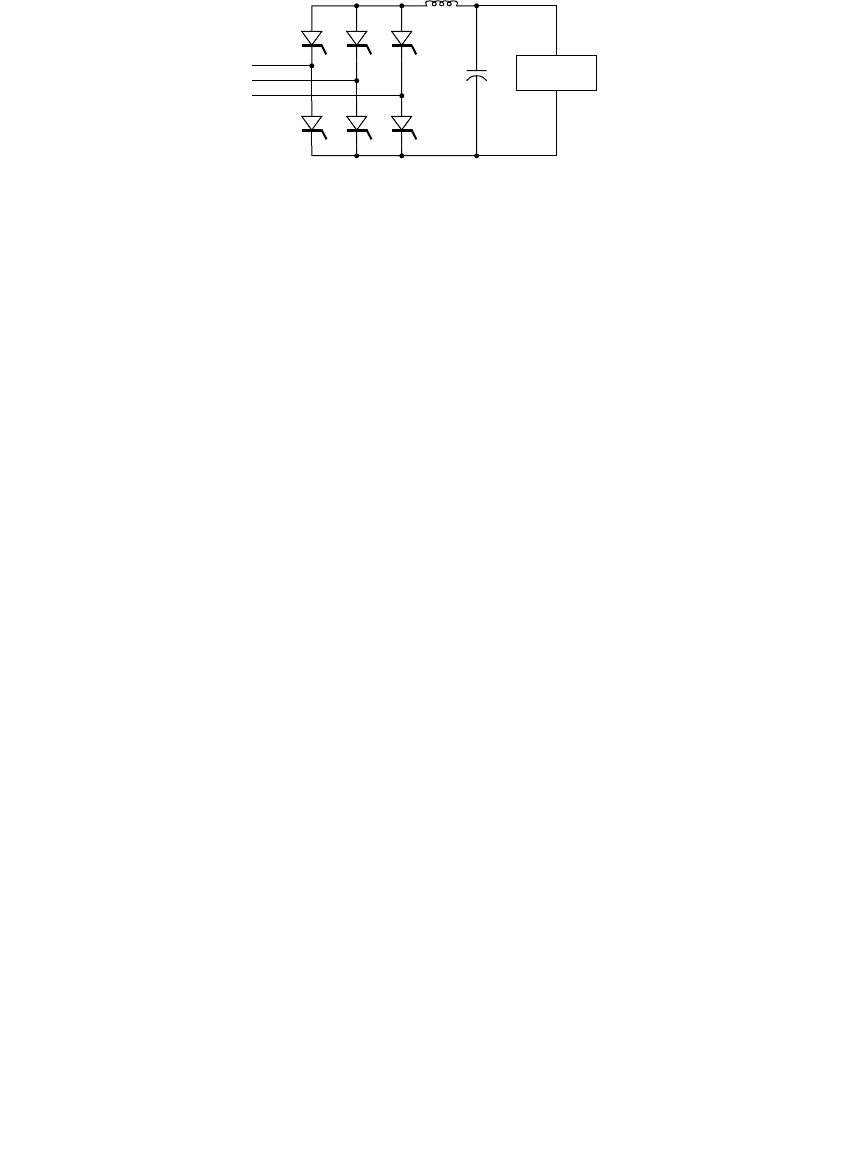Short T.A. Electric Power Distribution Handbook
Подождите немного. Документ загружается.


14
Distributed Generation
Distributed generation (DG) or embedded generation (the European term)
refers to generation applied at the distribution level. EPRI (1998) defines
distributed generation as the “utilization of small (0 to 5 MW), modular
power generation technologies dispersed throughout a utility’s distribution
system in order to reduce T&D loading or load growth and thereby defer
the upgrade of T&D facilities, reduce system losses, improve power quality,
and reliability.”
No exact size or voltages are accepted as definitions of distributed gener-
ation. A draft IEEE standard (IEEE P1547-D11-2003) applies to generation
under 10 MW. Distribution substation generation is normally considered as
distributed generation; sometimes subtransmission-level generation is also
considered as DG since many of the application issues are the same. Related
terms — non-utility generator (NUG) and independent power producer
(IPP) — refer to independent generation that may or may not be at the
distribution level. A broader term, distributed resources (DR), encompasses
distributed generation, backup generation, energy storage, and demand side
management (DSM) technologies.
Smaller-sized generators continue to improve in cost and efficiency, mov-
ing closer and closer to the performance of large power plants. At the same
time, utilities face significant obstacles when building large facilities — both
power plants and transmission lines. Utilities or end users can install mod-
ular distributed generation quickly. This local generation reduces the need
for large-scale utility projects. Distributed generation can allow utilities to
defer transmission and distribution upgrades. Also, DG reduces losses and
improves voltage. With the right configuration, distributed generation can
also improve customer reliability and power quality.
Both utilities and end users can install distributed generators, usually for
different reasons. Distributed generators are most cost effective if the cus-
tomer has need for
•
Cogeneration
— Using the generator waste heat locally significantly
improves the economics of many applications. Uses include process
steam, heating water, facility heat, or running air conditioning.
1791_book.fm Page 699 Monday, August 4, 2003 3:20 PM
(C) 2004 by CRC Press LLC

700
Electric Power Distribution Handbook
•
Reliability
— Many locations need backup generation for reliability
purposes. Once they are bought, running them full time or for peak
shaving becomes more economical.
Utilities most need local generation with
•
Overloaded circuits
— Distributed generation can delay infrastructure
upgrades.
•
Generation shortages
— If a utility needs generation anywhere it can
get it, the utility or end users can quickly install distributed generation.
Applying generation closer to the load benefits the transmission and dis-
tribution infrastructure. Local generation can relieve overburdened trans-
mission and distribution facilities as well as reduce losses and voltage drop.
While offering benefits and opportunities, generation is not always easy
to integrate into existing distribution systems (Barker and De Mello, 2000;
CEA 128 D 767, 1994; EPRI 1000419, 2000). Distribution systems were never
designed to include generation; they were designed for one-way power flow,
from the utility substation to the end users. Generators violate this basic
assumption, and generators can disrupt distribution operations if they are
not carefully applied. One of the most critical situations is that a distribution
interrupter may isolate a section of circuit, and the generator might continue
supplying the load on that section in an
island
. Islanding poses safety haz-
ards, and islanded generators can cause overvoltages on the circuit. In addi-
tion to islanding, generators can disturb protection, upset voltage regulation,
and cause other power quality problems. We will investigate many of these
issues in this chapter, how to identify problems and options for fixing them.
In addition to the technical difficulties, distributed generation raises sev-
eral other issues. How do we meter a generator? What is a fair price to pay
a generator injecting power into the system? How can distributed generators
be dispatched or controlled, especially if they are owned by end users? How
can we apply the generators to optimal locations on the system, rather than
just accepting it wherever end users install it?
Many distributed generation technologies can supply isolated loads on
their own, but massive disconnections from the utility to stand-alone systems
are unlikely in the near term. The utility distribution system solves many of
the problems with stand-alone generation systems:
•
Reliability
— Generators must be applied in redundant fashion to
achieve the reliability of normal distribution service. Together, a
utility service along with local generators has much higher than
normal reliability.
•
Matching load —
Many small generators are most economical when
they run at full power all of the time, but most loads have an average
power demand that is well below the peak. A utility source allows
the generator to run at full power, and the utility can offset the power
1791_book.fm Page 700 Monday, August 4, 2003 3:20 PM
(C) 2004 by CRC Press LLC

Distributed Generation
701
for the load. In addition, much of the renewable generation is inter-
mittent. Without a utility interconnection, renewable sites must have
energy storage, which is expensive.
•
Load following
— Many distributed generation designs have limited
load-following capability. Step changes in load or motor starting can
deeply affect the voltage and frequency.
The utility supply has the benefit of tying thousands of generators together,
providing reliability and matching load. In the future, small generators may
be applied locally in ways that gain some of these same benefits as the bulk
utility system.
Microgrids
tie generators together on a localized scale to gain
many of the reliability and load matching advantages of the traditional utility
grid (EPRI 1003973, 2001).
Distributed generation technologies continue to advance: cost comes
down, performance improves. Projections of penetration of distributed gen-
eration into the electrical system vary widely. Since natural gas delivers
energy at a cost that is roughly one fourth of the cost of electric energy, if
an efficient, low-capital-cost, and low-maintenance distributed generator
becomes available, gas energy delivery has an advantage over electric energy
delivery. Utilities must prepare for several scenarios and consider distributed
generators as another tool for supplying end users with electric power.
14.1 Characteristics of Distributed Generators
14.1.1 Energy Sources
Several energy sources drive distributed generators including
• Reciprocating engines
• Combustion turbines
• Microturbines
•Wind turbines
• Fuel cells
• Photovoltaics
Three power converters convert the power output of the energy source to
interface with standard 50- or 60-Hz systems:
• Synchronous generator
• Induction generator
• Inverter
1791_book.fm Page 701 Monday, August 4, 2003 3:20 PM
(C) 2004 by CRC Press LLC

702
Electric Power Distribution Handbook
Normally, reciprocating engines and combustion turbines interface
through synchronous generators. Microturbines, many wind turbines, fuel
cells, and photovoltaics interface through inverters.
Three factors are considerations for the energy source: the stability of the
power source, the ability to follow changes in load, and the reliability (avail-
ability) of the source.
On reciprocating engines, combustion turbines, and microturbines, the
burn rate of the fuel/air mixture controls the power output. The real power
output is controllable and responds to load changes fairly quickly. These
combustion-based generators are normally very stable sources (unless the
fuel supply is poor).
Wind turbines and photovoltaics produce variable output that is nor-
mally not controllable. One of the main concerns of wind turbines on
distribution circuits is the possibility of voltage flicker due to pulsating
output, mainly because the tower shades the blades for part of their rota-
tion. Sunshine variability also causes variation in solar-panel outputs, but
the changes are normally slow enough to limit flicker problems. Neither
of these can follow load.
Fuel cells have load-following capability, but it is significantly slower than
combustion generators. Fuel cells and photovoltaics have no natural provi-
sion to provide short-time overloads (some manufacturers include batteries
or ultracapacitors to add this capability). This helps control fault currents
but limits their ability to supply motor starting current and respond to loads.
The availability and reliability of the energy source plays a role in some
applications. Combustion engines and turbines are easily dispatchable. Pho-
tovoltaics and wind generation are non-dispatchable; the energy source is
not always available. Small hydro units may or may not be dispatchable,
depending on the water levels.
14.1.2 Synchronous Generators
The workhorse power generator for over a century, the synchronous gener-
ator is the power converter of choice for most distributed power sources.
Reciprocating engines and gas turbines almost always interface with a syn-
chronous generator. A synchronous generator can operate independently or
in synchronization with the utility. Most distribution-scale generators are
salient-pole machines with four or six poles driven by 1800- or 1200-rpm
reciprocating engines (with some even slower in larger units). Distribution-
scale gas-turbines spin faster but are normally geared down to drive a salient-
pole generator at 1800 rpm.
Synchronous generators can operate at leading or lagging power factor and
can operate in a voltage control or voltage following mode. Most distributed
synchronous generators use a voltage-following control mode. This differs
from large generators on the electric system, which have controls to regulate
voltage (within the limits of the var capability). Distributed generators nor-
mally follow the utility voltage and inject a constant amount of real and reactive
1791_book.fm Page 702 Monday, August 4, 2003 3:20 PM
(C) 2004 by CRC Press LLC

Distributed Generation
703
power (so the power factor stays constant). Normally, most DG operators run
at unity power factor since that produces the most watts for a given kVA rating.
The three-phase ac power system connects to the armature winding on
the stator (the outside, nonmoving part) of the synchronous machine (Figure
14.1). The stator wraps around the outside of the generator, so it can couple
magnetically with the rotating magnetic field produced on the rotor. The
rotor has a dc magnetic field rotating at synchronous speed. The rotor has
several poles around the shaft. Each pole is a piece of iron with a coil
wrapped around it (the field winding). The field winding forms an electro-
magnet that creates the dc magnetic field. A separate device, an exciter,
generates the dc current for the field winding. The rotating dc magnetic field
induces an emf in the stator (armature) winding, which drives power into
FIGURE 14.1
Synchronous generator. (Courtesy of Caterpillar, Inc.)
1791_book.fm Page 703 Monday, August 4, 2003 3:20 PM
(C) 2004 by CRC Press LLC

704
Electric Power Distribution Handbook
the ac system. For more detailed descriptions, see one of the many machine
books available, such as Fitzgerald et al. (1971).
A voltage source (the emf induced on the armature) behind a reactance
models a synchronous machine well. Several impedances come into play
depending on the scenario:
•
Subtransient reactance
—
X
d
" is the positive-sequence impedance that
determines the three-phase fault current during the first few cycles.
Normally,
X
d
" is between 10 and 30% on the machine rating. Higher
values of
X
d
" limit the short-circuit current the machine supplies but
reduce the capability of the machine to respond quickly to load
changes.
•
Negative-sequence reactance
—
X
2
impacts the current under voltage
unbalance.
X
2
is equal to the average of
X
d
" and
X
q
" (the direct and
quadrature impedances) and is typically 10 to 30% on the machine
rating.
•
Zero-sequence reactance
—
X
0
affects ground-fault currents and the
flow of triplen harmonics. The zero-sequence reactance is normally
very low, even less than 5% on the machine rating.
In the absence of better information, assume
X
d
" = 20%,
X
2
= 25%, and
X
0
= 5% on the machine rating. In the past, this information was hard to obtain
for small machines, but now most generator manufacturers supply them.
Table 14.1 shows values of small generator constants from tests, with the
characteristics of machines C and D being most representative. Most of the
parameters in the table are only needed for very detailed simulations.
For fault calculations, the voltage behind the subtransient reactance is
normally in the range of 1.0 to 1.3 per unit with a typical value of 1.1. The
power factor ranges from 0.8 lagging to unity. So, with the voltage at 1.1 per
unit and
X
d
" = 20%, the initial three-phase fault current is 5.5 times the
generator rating.
Under a fault, sudden load change, or other transient condition, the sub-
transient reactance (
X
d
" which is often denoted as just
X
") dominates. After
a time equal to the subtransient time constant (
T
d
"), which ranges from 1 to
10 cycles, the transient reactance (
X
d
¢
) more accurately models the generator
response.
The direct-axis impedance (indicated by the subscript
d
) is the effective
impedance for changes that are in sync with rotation (50- or 60-Hz events).
Quadrature-axis impedances (subscript
q
) are the impedances seen with the
rotor out of phase with the stator field. For fault calculations we only need
to consider the direct-axis impedances. For unbalance or harmonics, the
quadrature-axis impedances have impacts.
The
saturated
subtransient reactance (
X
dv
") is used for short-circuit studies
and for harmonics. The subscripted “
v
” means constant voltage; the imped-
ance is the value of
V/I
at rated voltage and no load for a short circuit on
1791_book.fm Page 704 Monday, August 4, 2003 3:20 PM
(C) 2004 by CRC Press LLC

Distributed Generation
705
the generator terminals (which is a high-current condition that saturates the
magnetic core, which results in a lower impedance). Another version of
subtransient reactance, the unsaturated reactance (
X
di
") is used for stability
studies. Usually, if it is not indicated which value it is, it is the saturated
value,
X
dv
".
The negative-sequence reactance (
X
2
) and the subtransient reactance (
X
d
")
are determined mainly by the damper windings on the rotor. On a salient-
pole machine, damper windings are a shorted winding wound around each
pole. Damper windings react to dampen out transients on the machine. The
torque produced by the damper windings slows down a machine that is
running faster than synchronous speed, and it speeds up a machine that is
running slower than synchronous speed. Damper windings are like the rotor
on a squirrel-cage induction machine (in fact a squirrel-cage induction
machine is a synchronous machine with damper windings and no field on
the rotor). At synchronous speed, no current flows in the damper windings
since the flux on the rotor is dc, but if transients act to change the frequency
relative to the synchronous speed, currents flow in the damper windings
and create torque to counteract the disturbance. The damper windings also
TABLE 14.1
Small Synchronous Generator Constants in per Unit
on the Machine Base
Machine A B C D
kVA 69 156 781 1044
kW 55 125 625 835
V 240/480 240/480 240/480 240/480
rpm 1800 1800 1800 1800
H
gen
0.26 0.20 0.40 0.43
pf 0.80 0.80 0.80 0.80
X
d
2.02 6.16 2.43 2.38
X
d
'
0.171 0.347 0.254 0.264
X
d
"
0.087 0.291 0.207 0.201
X
q
1.06 2.49 1.12 1.10
X
q
"
0.163 0.503 0.351 0.376
T
do
'
(sec) 0.950 1.87 1.90 2.47
T
d
'
(sec) 0.080 0.105 0.198 0.273
T
do
"
(sec) 0.078 0.013 0.024 0.018
T
d
"
(sec) 0.004 0.011 0.020 0.014
T
qo
"
(sec) 0.045 0.020 0.016 0.009
T
q
"
(sec) 0.007 0.004 0.005 0.003
r
a
0.011 0.034 0.017 0.013
T
a
(sec) 0.014 0.022 0.038 0.032
X
0
0.038 0.054 0.051 0.074
X
2
0.125 0.375 0.279 0.260
Source:
Gish, W. B., “Small Induction Generator and Syn-
chronous Generator Constants for DSG Isolation Studies,”
IEEE Transactions on Power Systems
, vol. PWRD-1, no. 2,
pp. 231–9, April 1986. ©1986 IEEE.
1791_book.fm Page 705 Monday, August 4, 2003 3:20 PM
(C) 2004 by CRC Press LLC

706
Electric Power Distribution Handbook
react to other stator currents that are not 50- or 60-Hz positive-sequence
currents (significantly, negative-sequence currents and harmonic currents).
The negative-sequence impedance determines the current flow due to
negative-sequence voltages. The impedance to harmonic voltages is also
approximately the negative-sequence impedance. The negative-sequence
impedance is the same whether the generator is under steady-state, transient,
or subtransient conditions.
The zero-sequence impedance of a synchronous machine can have
extremely low impedance. It is enough of a problem that many generators
are ungrounded or grounded through an impedance to prevent the flow of
zero-sequence current. Many generators are not braced to handle the fault
current for a line-to-ground fault at the terminals of the machine. Single-
phase faults cause more mechanical stress and are higher magnitude. Ground
fault currents are 30 to 40% higher than three-phase fault currents (
E
/
X
d
" vs.
3
E
/(2
X
d
"+
X
0
)
ª
1.3 to 1.4
E
/
X
d
"). The zero-sequence impedance is the same
whether it is under steady-state, transient, or subtransient conditions.
The reason that the zero-sequence impedance is so low is that magnetic
fields from zero-sequence currents in the stator winding tend to cancel each
other. If the fields cancel and couple very little to the rotor, the impedance
is very low.
The zero-sequence impedance varies significantly with design. The most
prominent difference is due to the pitch of the stator winding. A pole pitch
is the number of degrees that the rotor has to move to change from one pole
to the other. In a 2-pole machine, one pole pitch is 180
∞
, and in a 4-pole
machine, it is 90
∞
. The
pitch factor
(or just the
pitch
) of the stator winding is
the portion of the pole pitch that the stator winding spans. A full-pitch stator
winding spans the full pitch. A fractional pitch winding spans less than the
full pitch. Figure 14.2 shows a comparison of a full-pitch winding and a 2/
3-pitch winding. In this figure, each phase has two windings (
a
1
and
a
2
for
example); the current in each winding goes out on one slot conductor (like
a
1
) and returns in another slot conductor labeled with the prime notation
(like
a
¢
1
). The 2/3-pitch winding reduces the zero-sequence impedance the
most. Because the two conductors in each slot have current in opposite
directions, the fields cancel almost completely (since
a = b = c =
-
a
¢
=
-
b
¢
=
-
c
¢
for zero-sequence current). Other common pitch factors are 5/8 and 3/4.
Synchronization is important when connecting synchronous generators. If
a large machine is out of synch with the utility when it is connected, the
sudden torque can damage the generator, and the connecting switch and
other devices will have a large voltage disturbance. To avoid these problems,
synchronizing relays are required for synchronous generators to ensure that
the voltage, frequency, phase angle, and phasing are the same on the utility
and generator. Normally, the generator is brought up to speed, and the field
current is adjusted to bring the voltage close to the utility system. The
frequency is more precisely adjusted to bring it within 0.5 Hz of the power
system. Then, the synchronizing relay allows closing when the two voltages
are within 10
∞
(CEA 128 D 767, 1994).
1791_book.fm Page 706 Monday, August 4, 2003 3:20 PM
(C) 2004 by CRC Press LLC

Distributed Generation
707
14.1.3 Induction Generators
Induction generators are used in a few distributed generation applications,
mainly wind-turbine applications where the speed of the prime mover varies.
Induction generators are simpler than synchronous generators. They do not
have exciters, voltage regulators, governors, or synchronizing equipment.
An induction generator is the same as an induction motor except the prime
mover turns the rotor faster than synchronous speed. An induction generator
needs supplemental excitation, either supplied by the utility system or local
capacitors.
To start some induction generators, the utility may accelerate the prime
mover to operational speed, drawing inrush to five or six times the generator
rating just like motor starting. A reduced-voltage starter using a reactor or
autotransformer reduces the inrush. If possible, the prime mover can accel-
erate the shaft to near synchronous speed before closing in; this softens the
inrush when connecting. This type of connection draws inrush of up to three
times the generator rating. Because the induction machine cannot generate
voltage on its own, the timing of the connection is unimportant.
Even though the induction generator cannot create voltage on its own, the
generator can self-excite with capacitors. Reclosing into a self-excited gen-
erator with local capacitors can damage the shaft and other equipment.
Under transient conditions, induction machines respond similarly to syn-
chronous machines. Under fault-type transient conditions,
X
1
=
X
2
= 20% (the
locked-rotor impedance) and
X
0
= 5%. The voltage behind the positive-
sequence impedance is also about 1.1 per unit. The main difference between
synchronous and induction machines is that the generator driving voltage
collapses more quickly in an induction machine.
FIGURE 14.2
Comparison of a full-pitch and a 2/3-pitch stator winding for a two-pole machine with a double-
layer stator winding with one slot per phase per pole.
Full-pitch winding Two-thirds-pitchwinding
a
1
a
2
a
2
a
1
b
1
b
2
b
2
b
1
c
1
c
2
c
2
c
1
a
1
a
2
a
2
a
1
b
1
b
2
b
2
b
1
c
1
c
2
c
2
c
1
a
2
a
1
b
2
b
1
c
2
c
1
a
1
a
2
a
2
a
1
b
1
b
2
b
2
b
1
c
1
c
2
c
2
c
1
1791_book.fm Page 707 Monday, August 4, 2003 3:20 PM
(C) 2004 by CRC Press LLC

708
Electric Power Distribution Handbook
14.1.4 Inverters
Many types of small generators best interface with utility and utilization
power through an inverter. Photovoltaics and fuel cells generate dc. Wind
turbines and microturbines generate incompatible frequencies, so they are
best applied by rectifying to dc then converting back to ac with an inverter.
Two main classes of inverters are
• Line commutated
• Self commutated
A three-phase line-commutated inverter is the simplest and least expensive
converter. Thyristors (also called silicon-controlled rectifiers or SCRs) in a
full-wave bridge configuration convert from dc to ac by switching current
(see Figure 14.3). Thyristors can switch large amounts of current at low loss.
The inverter controls when to turn on the thyristor by applying a voltage
pulse to the gate of the thyristor; the thyristor does not turn off until the
next current zero.
Since a line-commutated inverter draws currents in square waves, it creates
large harmonics, primarily the 5th, 7th, 11th, and 13th. Line-commutated
inverters require significant reactive power from the system, between 10 and
40% of the inverter rating. It is possible to use 12-, 18-, or 24-pulse bridge
designs with phase-shifting transformers to reduce harmonics.
Line-commutated inverters do not provide significant fault current. The
reactor in the inverter limits the fault current. Most designs limit current to
100 to 400% of the inverter rating. Usually inverters have overcurrent pro-
tection that removes the firing pulses when current exceeds some threshold.
The duration of fault current output also depends on the amount of capac-
itance on the inverter dc bus. Note that a harmonic filter on the output can
increase the momentary fault value.
The self-commutated inverter can generate its own sinusoidal voltage.
Although several self-commutated configurations are around, the most com-
mon is the fast switching pulse-width modulation (PWM) design using
insulated gate bipolar transistors (IGBTs) or other switchable power elec-
tronic components. IGBTs can be turned on and off quickly. By controlling
FIGURE 14.3
Common three-phase bridge inverter line-commutated configuration with thyristors.
dc source
1791_book.fm Page 708 Monday, August 4, 2003 3:20 PM
(C) 2004 by CRC Press LLC
